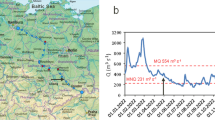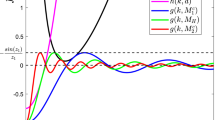Abstract
A reaction–diffusion–advection equation with strong Allee effect growth rate is proposed to model a single species stream population in a unidirectional flow. Here random undirected movement of individuals in the environment is described by passive diffusion, and an advective term is used to describe the directed movement in a river caused by the flow. Under biologically reasonable boundary conditions, the existence of multiple positive steady states is shown when both the diffusion coefficient and the advection rate are small, which lead to different asymptotic behavior for different initial conditions. On the other hand, when the advection rate is large, the population becomes extinct regardless of initial condition under most boundary conditions. It is shown that the population persistence or extinction depends on Allee threshold, advection rate, diffusion coefficient and initial conditions, and there is also rich transient dynamical behavior before the eventual population persistence or extinction.
















Similar content being viewed by others
References
Ai S-B, Chen X-F, Hastings SP (2006) Layers and spikes in non-homogeneous bistable reaction–diffusion equations. Trans Am Math Soc 358(7):3169–3206
Alikakos ND, Bates PW, Fusco G (1993) Solutions to the nonautonomous bistable equation with specified Morse index. I. Existence. Trans Am Math Soc 340(2):641–654
Allee WC (1931) Animal aggregations. A study in general sociology. University of Chicago Press, Chicago
Amann H (1976) Fixed point equations and nonlinear eigenvalue problems in ordered Banach spaces. SIAM Rev 18(4):620–709
Ambrosetti A, Rabinowitz PH (1973) Dual variational methods in critical point theory and applications. J Funct Anal 14:349–381
Belgacem F, Cosner C (1995) The effects of dispersal along environmental gradients on the dynamics of populations in heterogeneous environments. Can Appl Math Quart 3(4):379–397
Brashares JS, Werner JR, Sinclair ARE (2010) Social ‘meltdown’ in the demise of an island endemic: Allee effects and the Vancouver Island marmot. J Anim Ecol 79(5):965–973
Cantrell RS, Cosner C (2003) Spatial ecology via reaction–diffusion equations. Wiley series in mathematical and computational biology. Wiley, Chichester
Cantrell RS, Cosner C, Lou Y (2006) Movement toward better environments and the evolution of rapid diffusion. Math Biosci 204(2):199–214
Cantrell RS, Cosner C, Lou Y (2007) Advection-mediated coexistence of competing species. Proc R Soc Edinb Sect A 137(3):497–518
Carr J, Pego RL (1989) Metastable patterns in solutions of \(u_t=\epsilon ^2u_{xx}-f(u)\). Commun Pure Appl Math 42(5):523–576
Chen X-F, Hambrock R, Lou Y (2008) Evolution of conditional dispersal: a reaction–diffusion–advection model. J Math Biol 57(3):361–386
Chen X-F, Lam K-Y, Lou Y (2012) Dynamics of a reaction–diffusion–advection model for two competing species. Discrete Contin Dyn Syst 32(11):3841–3859
Chen X-F, Lou Y (2008) Principal eigenvalue and eigenfunctions of an elliptic operator with large advection and its application to a competition model. Indiana Univ Math J 57(2):627–658
Coddington EA, Levinson N (1955) Theory of ordinary differential equations. McGraw-Hill Book Company Inc, New York
Cosner C, Lou Y (2003) Does movement toward better environments always benefit a population? J Math Anal Appl 277(2):489–503
Courchamp F, Berec L, Gascoigne J (2008) Allee effects in ecology and conservation. Oxford University Press, Oxford
Cui R-H, Lam K-Y, Lou Y (2017) Dynamics and asymptotic profiles of steady states of an epidemic model in advective environments. J Differ Equ 263(4):2343–2373
Dancer EN, Schmitt K (1987) On positive solutions of semilinear elliptic equations. Proc Am Math Soc 101(3):445–452
De Roos AM, Persson L (2002) Size-dependent life-history traits promote catastrophic collapses of top predators. Proc Natl Acad Sci USA 99(20):12907–12912
Du Y-H, Matano H (2010) Convergence and sharp thresholds for propagation in nonlinear diffusion problems. J Eur Math Soc 12(2):279–312
Epstein IR, Pojman JA (1998) An introduction to nonlinear chemical dynamics: oscillations, waves, patterns, and chaos. Oxford University Press, Oxford
Fusco G, Hale JK (1989) Slow-motion manifolds, dormant instability, and singular perturbations. J Dyn Differ Equ 1(1):75–94
Fusco G, Hale JK, Xun J-P (1996) Traveling waves as limits of solutions on bounded domains. SIAM J Math Anal 27(6):1544–1558
Gascoigne J, Lipcius RN (2004) Allee effects in marine systems. Mar Ecol Progr Ser 269:49–59
Gascoigne JC, Lipcius RN (2004) Allee effects driven by predation. J Appl Ecol 41(5):801–810
Hadeler KP, Rothe F (1975) Travelling fronts in nonlinear diffusion equations. J Math Biol 2(3):251–263
Hale JK, Sakamoto K (1988) Existence and stability of transition layers. Jpn J Appl Math 5(3):367–405
Henry D (1981) Geometric theory of semilinear parabolic equations. Lecture notes in mathematics, vol 840. Springer, Berlin
Hsu S-B, Lou Y (2010) Single phytoplankton species growth with light and advection in a water column. SIAM J Appl Math 70(8):2942–2974
Huang Q-H, Jin Y, Lewis MA (2016) \(R_0\) analysis of a Benthic-drift model for a stream population. SIAM J Appl Dyn Syst 15(1):287–321
Huisman J, Arrayás M, Ebert U, Sommeijer B (2002) How do sinking phytoplankton species manage to persist? Am Nat 159(3):245–254
Hutson V, Martinez S, Mischaikow K, Vickers GT (2003) The evolution of dispersal. J Math Biol 47(6):483–517
Jacobsen J, Jin Y, Lewis MA (2015) Integrodifference models for persistence in temporally varying river environments. J Math Biol 70(3):549–590
Jin Y, Hilker FM, Steffler PM, Lewis MA (2014) Seasonal invasion dynamics in a spatially heterogeneous river with fluctuating flows. Bull Math Biol 76(7):1522–1565
Jin Y, Lewis MA (2011) Seasonal influences on population spread and persistence in streams: critical domain size. SIAM J Appl Math 71(4):1241–1262
Jin Y, Lewis MA (2012) Seasonal influences on population spread and persistence in streams: spreading speeds. J Math Biol 65(3):403–439
Jin Y, Lutscher F, Pei Y (2017) Meandering rivers: how important is lateral variability for species persistence? Bull Math Biol 79(12):2954–2985
Jordan-Cooley WC, Lipcius RN, Shaw LB, Shen J, Shi J-P (2011) Bistability in a differential equation model of oyster reef height and sediment accumulation. J Theor Biol 289:1–11
Keitt TH, Lewis MA, Holt RD (2001) Allee effects, invasion pinning, and species’ borders. Am Nat 157(2):203–216
Kot M, Lewis MA, van den Driessche P (1996) Dispersal data and the spread of invading organisms. Ecology 77(7):2027–2042
Kramer AM, Dennis B, Liebhold AM, Drake JM (2009) The evidence for Allee effects. Popul Ecol 51(3):341–354
Lam K-Y (2011) Concentration phenomena of a semilinear elliptic equation with large advection in an ecological model. J Differ Equ 250(1):161–181
Lam K-Y (2012) Limiting profiles of semilinear elliptic equations with large advection in population dynamics II. SIAM J Math Anal 44(3):1808–1830
Lam KY, Lou Y, Lutscher F (2015) Evolution of dispersal in closed advective environments. J Biol Dyn 9(suppl. 1):188–212
Lam KY, Lou Y, Lutscher F (2016) The emergence of range limits in advective environments. SIAM J Appl Math 76(2):641–662
Lam K-Y, Ni W-M (2010) Limiting profiles of semilinear elliptic equations with large advection in population dynamics. Discrete Contin Dyn Syst 28(3):1051–1067
Lewis MA, Kareiva P (1993) Allee dynamics and the spread of invading organisms. Theor Popul Biol 43(2):141–158
Liu G-Q, Wang Y-W, Shi J-P (2009) Existence and nonexistence of positive solutions of semilinear elliptic equation with inhomogeneous strong Allee effect. Appl Math Mech Engl Ed 30(11):1461–1468
Lou Y, Lutscher F (2014) Evolution of dispersal in open advective environments. J Math Biol 69(6–7):1319–1342
Lou Y, Xiao DM, Zhou P (2016) Qualitative analysis for a Lotka–Volterra competition system in advective homogeneous environment. Discrete Contin Dyn Syst 36(2):953–969
Lou Y, Zhao X-Q, Zhou P (2019) Global dynamics of a Lotka–Volterra competition–diffusion–advection system in heterogeneous environments. J Math Pures Appl 9(121):47–82
Lou Y, Zhou P (2015) Evolution of dispersal in advective homogeneous environment: the effect of boundary conditions. J Differ Equ 259(1):141–171
Lutscher F, Lewis MA, McCauley E (2006) Effects of heterogeneity on spread and persistence in rivers. Bull Math Biol 68(8):2129–2160
Lutscher F, Nisbet RM, Pachepsky E (2010) Population persistence in the face of advection. Theor Ecol 3(4):271–284
Lutscher F, Pachepsky E, Lewis MA (2005) The effect of dispersal patterns on stream populations. SIAM J Appl Math 65(4):1305–1327
Maciel GA, Lutscher F (2015) Allee effects and population spread in patchy landscapes. J Biol Dyn 9(1):109–123
Mckenzie HW, Jin Y, Jacobsen J, Lewis MA (2012) \(R_0\) analysis of a spatiotemporal model for a stream population. SIAM J Appl Dyn Syst 11(2):567–596
Muratov CB, Zhong X (2013) Threshold phenomena for symmetric decreasing solutions of reaction–diffusion equations. NoDEA Nonlinear Differ Equ Appl 20(4):1519–1552
Nakashima K (2003) Multi-layered stationary solutions for a spatially inhomogeneous Allen–Cahn equation. J Differ Equ 191(1):234–276
Ni W-M (2011) The mathematics of diffusion, CBMS-NSF regional conference series in applied mathematics, vol 82. Society for Industrial and Applied Mathematics (SIAM), Philadelphia
Okubo A, Levin SA (2001) Diffusion and ecological problems: modern perspectives. Interdisciplinary applied mathematics, vol 14, 2nd edn. Springer, New York
Ouyang TC, Shi J-P (1998) Exact multiplicity of positive solutions for a class of semilinear problems. J Differ Equ 146(1):121–156
Pachepsky E, Lutscher F, Nisbet RM, Lewis MA (2005) Persistence, spread and the drift paradox. Theor Popul Biol 67(1):61–73
Pao CV (1992) Nonlinear parabolic and elliptic equations. Plenum Press, New York
Prigogine I, Lefever R (1968) Symmetry breaking instabilities in dissipative systems. II. J Chem Phys 48(4):1698–1700
Rabinowitz PH (1973/1974) Pairs of positive solutions of nonlinear elliptic partial differential equations. Indiana Univ Math J 23:173–186
Rabinowitz PH (1986) Minimax methods in critical point theory with applications to differential equations. CBMS regional conference series in mathematics, vol 65. American Mathematical Society, Providence
Ramirez JM (2012) Population persistence under advection–diffusion in river networks. J Math Biol 65(5):919–942
Rowe S, Hutchings JA, Bekkevold D, Rakitin A (2004) Depensation, probability of fertilization, and the mating system of Atlantic cod (Gadus Morhua L.). ICES J Mar Sci 61(7):1144–1150
Sarhad J, Carlson R, Anderson KE (2014) Population persistence in river networks. J Math Biol 69(2):401–448
Sattinger DH (1971/1972) Monotone methods in nonlinear elliptic and parabolic boundary value problems. Indiana Univ Math J 21:979–1000
Shi J-P, Shivaji R (2006) Persistence in reaction diffusion models with weak Allee effect. J Math Biol 52(6):807–829
Smoller J (1983) Shock waves and reaction-diffusion equations. Grundlehren der Mathematischen Wissenschaften (Fundamental principles of mathematical science), vol 258. Springer, New York
Speirs DC, Gurney WSC (2001) Population persistence in rivers and estuaries. Ecology 82(5):1219–1237
Stephens PA, Sutherland WJ (1999) Consequences of the Allee effect for behaviour, ecology and conservation. Trends Ecol Evol 14(10):401–405
Sullivan LL, Li B-T, Miller T, Neubert MG, Shaw AK (2017) Density dependence in demography and dispersal generates fluctuating invasion speeds. Proc Natl Acad Sci 114(19):5053–5058
Swift M, Lam K-Y, Shaw LB, Shi J-P (2018) Dispersal-induced global extinction in a two-patch model with Allee effect (preprint)
Vasilyeva O, Lutscher F (2010) Population dynamics in rivers: analysis of steady states. Can Appl Math Q 18(4):439–469
Vasilyeva O, Lutscher F (2012) Competition of three species in an advective environment. Nonlinear Anal Real World Appl 13(4):1730–1748
Wang J-F, Shi J-P, Wei J-J (2011) Dynamics and pattern formation in a diffusive predator-prey system with strong Allee effect in prey. J Differ Equ 251(4–5):1276–1304
Wang M-H, Kot M (2001) Speeds of invasion in a model with strong or weak Allee effects. Math Biosci 171(1):83–97
Wang M-H, Kot M, Neubert MG (2002) Integrodifference equations, Allee effects, and invasions. J Math Biol 44(2):150–168
Zhao XQ, Zhou P (2016) On a Lotka–Volterra competition model: the effects of advection and spatial variation. Calc Var Partial Differ Equ 55(4):25 (Art. 73)
Zhou P (2016) On a Lotka–Volterra competition system: diffusion vs advection. Calc Var Partial Differ Equ 55(6):29 (Art. 137)
Zhou P, Xiao D-M (2018) Global dynamics of a classical Lotka–Volterra competition–diffusion–advection system. J Funct Anal 275(2):356–380
Zhou P, Zhao XQ (2018) Evolution of passive movement in advective environments: general boundary condition. J Differ Equ 264(6):4176–4198
Zlatoš A (2006) Sharp transition between extinction and propagation of reaction. J Am Math Soc 19(1):251–263
Acknowledgements
The authors sincerely thank two anonymous reviewers for their very careful readings and helpful suggestions which significantly improved the initial draft.
Author information
Authors and Affiliations
Corresponding author
Additional information
Publisher's Note
Springer Nature remains neutral with regard to jurisdictional claims in published maps and institutional affiliations.
Partially supported by a grant from China Scholarship Council, NSF Grant DMS-1715651.
Rights and permissions
About this article
Cite this article
Wang, Y., Shi, J. & Wang, J. Persistence and extinction of population in reaction–diffusion–advection model with strong Allee effect growth. J. Math. Biol. 78, 2093–2140 (2019). https://doi.org/10.1007/s00285-019-01334-7
Received:
Revised:
Published:
Issue Date:
DOI: https://doi.org/10.1007/s00285-019-01334-7




